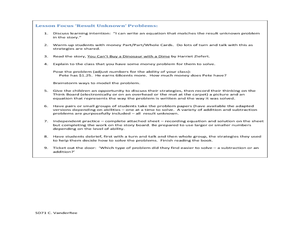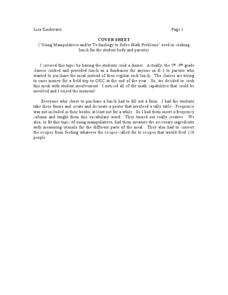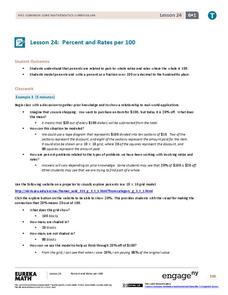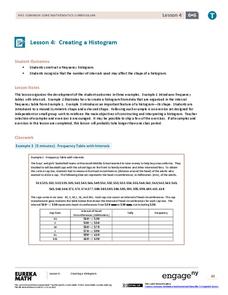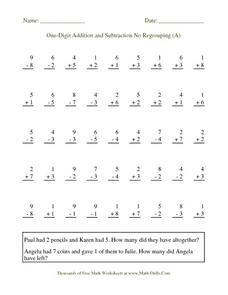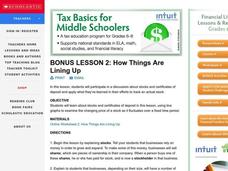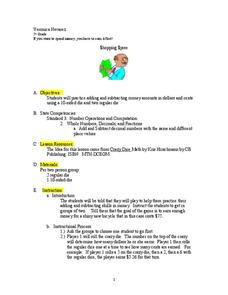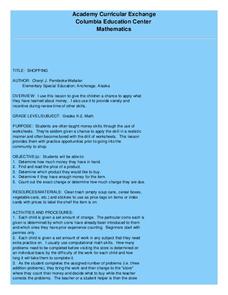Curated OER
Book Title: You Can’t Buy a Dinosaur with a Dime
Students explore the concepts of multiple digit addition and subtraction. In this addition and subtraction instructional activity, students read the book You Can’t Buy a Dinosaur with a Dime and then discuss methods for solving a...
Curated OER
My Bank, My Budget, My Decisions
Students create a personal budget. In this financial planning lesson, students create a budget using income data and identify ways to save a portion of money for donations.
Curated OER
Adding and Subtracting Decimals
Students practice adding and subtracting numbers with decimals. In this decimals lesson plan, students use grid paper and money to learn how to add and subtract decimals.
Curated OER
Planning and Shopping for the Menu
Students plan a menu considering the number of people to be served and the amount of money they have to work with to buy the necessary ingredients.
Curated OER
"Using Manipulatives and/or Technology to Solve Math Problems" by Cooking Dinner
Students explore math functions by preparing a meal. In this food measurement lesson, students examine a recipe for a meal and alter the size of the recipe based upon the amount of servings needed. Students utilize manipulatives to...
EngageNY
More Examples of Functions
Discrete or not discrete? Individuals learn about the difference between discrete and non-discrete functions in the fourth installment of a 12-part module. They classify some examples of functions as being either discrete or non-discrete.
EngageNY
Linear Functions and Proportionality
Connect linear equations, proportionality, and constant rates of change to linear functions. Young mathematicians learn how linear equations of the form y = mx + b can represent linear functions. They then explore examples of linear...
EngageNY
Percent and Rates per 100
What percentage of your class understands percents? Pupils learn the meaning of percents based upon rates per 100 in the 24th lesson in a series of 29. They represent percents as fractions, decimals, ratios, and models. The scholars...
EngageNY
Comparison Shopping—Unit Price and Related Measurement Conversions II
Which rate is greater and by how much? Pupils continue to compare rates to solve problems in the 20th portion of a 29-part series. Rates are presented in a variety of representations either using the same representation or different...
EngageNY
Conducting a Simulation to Estimate the Probability of an Event
How can you complete a simulation when it is not practical to determine the probability of an event? Class members learn that in some situations, it is not feasible to find the probability of an event, but they can estimate it by running...
EngageNY
Creating a Histogram
Display data over a larger interval. The fourth segment in a 22-part unit introduces histograms and plotting data within intervals to the class. Pupils create frequency tables with predefined intervals to build histograms. They describe...
Curated OER
One-Digit Addition and Subtraction No Regrouping (A)
In this math worksheet, students solve 81 problems in which one-digit numbers are added and subtracted. Problems are in a vertical format with addition and subtraction mixed in each row.
Curated OER
Math and Money
Students explore financial literacy. In this middle school mathematics lesson, students investigate income, taxes, and costs of living. Students investigate banking and use straightforward computation to learn about savings, simple...
Curated OER
Primary Counting Skills
Class members drill and practice counting skills from 1 to 20. They count along with a puppet and when the puppet makes a mistake, they correct it. In pairs, they connect cubes to make a train and count the number used. On the last of...
Curated OER
I Have a Magic Pot
Pupils will explore numbers rules. They will create a picture of their rule and exchange their paper with a classmate. The classmate works to figure out the rule. They then share with each other how they found the rule. Questions are...
Henrico County Public Schools
Models for Teaching Addition and Subtraction of Integers
Positive and negative numbers are everywhere in the world around us. Whether it's charged particles in atoms, a hot air balloon rising and falling in the sky, or a series of bills and checks being delivered in the mail, this resource...
Virginia Department of Education
Road Trip
Help plan a road trip with linear equations. Scholars consider two different rental car companies and write equations representing the cost for each company. They graph the system of equations to determine the conditions under which each...
Virginia Department of Education
Probability
Classes explore different scenarios using manipulatives to learn about the difference between independent and dependent probability. Learners experiment with colored chips to model the two types of probabilities. To test their...
Virginia Department of Education
Greetings
Welcome learners to the world of algebra. Use a instructional activity that poses a situation involving the profit from creating greeting cards to teach about algebra. It requires scholars to use linear functions and inequalities to...
Virginia Department of Education
Functions 1
Scholars learn what it means for a relation to be a function and see various representations of functions. After learning the definition, they participate in a card sorting activity classifying relations as functions or not.
Virginia Department of Education
Scientific Notation
Writing a number is all in the notation. The resource introduces the class to scientific notation. Pupils learn the process of taking a very large or small number in standard form and write it in scientific notation. To practice,...
Curated OER
Saving Money Through Mathematics
Third graders discuss light sources and collect data about energy sources. They compare data and create a multiple line graph showing energy used by light sources for each student in the group. They present their graphs and write a...
Curated OER
Shopping Spree
Sixth graders examine currency by completing monetary equations. In this economics lesson, 6th graders participate in a numbers experiment where they roll a die and earn money based on their roll. Students compete for their fictitious...
Curated OER
Shopping
Students determine how much money they have in hand, find and read the price of a product, determine which product to buy, determine if they have enough money, and count out exact change or determine how much change is due.
Other popular searches
- Money Math Centers
- Three Little Pigs Money Math
- Money Math Worksheets
- Counting Money Math
- Money Math Activities
- Math Money
- Money Math Match
- Subtracting Money Math
- Math Money Lessons
- Counting Money Math Lessons
- Money Math and Music
- Maths Money Lesson Plans


